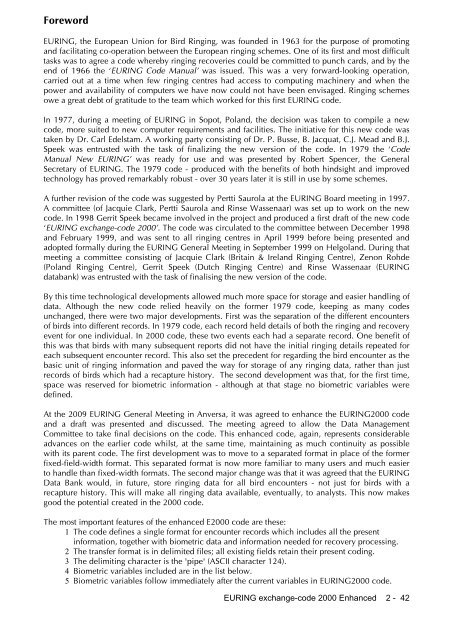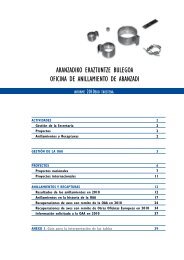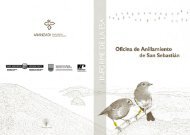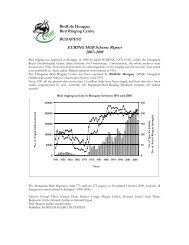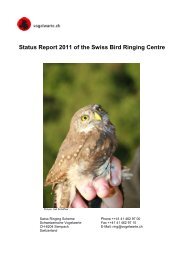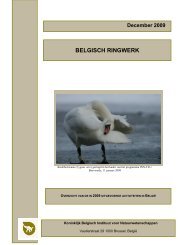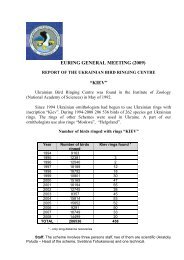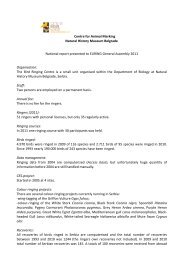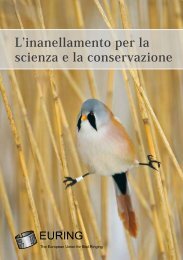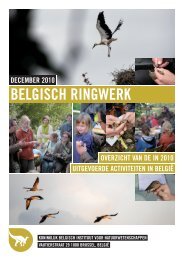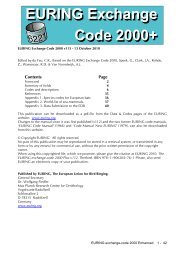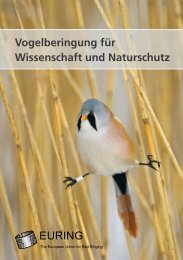here - The European Union for Bird Ringing
here - The European Union for Bird Ringing
here - The European Union for Bird Ringing
You also want an ePaper? Increase the reach of your titles
YUMPU automatically turns print PDFs into web optimized ePapers that Google loves.
Foreword<br />
EURING, the <strong>European</strong> <strong>Union</strong> <strong>for</strong> <strong>Bird</strong> <strong>Ringing</strong>, was founded in 1963 <strong>for</strong> the purpose of promoting<br />
and facilitating co-operation between the <strong>European</strong> ringing schemes. One of its first and most difficult<br />
tasks was to agree a code w<strong>here</strong>by ringing recoveries could be committed to punch cards, and by the<br />
end of 1966 the ‘EURING Code Manual’ was issued. This was a very <strong>for</strong>ward-looking operation,<br />
carried out at a time when few ringing centres had access to computing machinery and when the<br />
power and availability of computers we have now could not have been envisaged. <strong>Ringing</strong> schemes<br />
owe a great debt of gratitude to the team which worked <strong>for</strong> this first EURING code.<br />
In 1977, during a meeting of EURING in Sopot, Poland, the decision was taken to compile a new<br />
code, more suited to new computer requirements and facilities. <strong>The</strong> initiative <strong>for</strong> this new code was<br />
taken by Dr. Carl Edelstam. A working party consisting of Dr. P. Busse, B. Jacquat, C.J. Mead and B.J.<br />
Speek was entrusted with the task of finalizing the new version of the code. In 1979 the ‘Code<br />
Manual New EURING’ was ready <strong>for</strong> use and was presented by Robert Spencer, the General<br />
Secretary of EURING. <strong>The</strong> 1979 code - produced with the benefits of both hindsight and improved<br />
technology has proved remarkably robust - over 30 years later it is still in use by some schemes.<br />
A further revision of the code was suggested by Pertti Saurola at the EURING Board meeting in 1997.<br />
A committee (of Jacquie Clark, Pertti Saurola and Rinse Wassenaar) was set up to work on the new<br />
code. In 1998 Gerrit Speek became involved in the project and produced a first draft of the new code<br />
‘EURING exchange-code 2000’. <strong>The</strong> code was circulated to the committee between December 1998<br />
and February 1999, and was sent to all ringing centres in April 1999 be<strong>for</strong>e being presented and<br />
adopted <strong>for</strong>mally during the EURING General Meeting in September 1999 on Helgoland. During that<br />
meeting a committee consisting of Jacquie Clark (Britain & Ireland <strong>Ringing</strong> Centre), Zenon Rohde<br />
(Poland <strong>Ringing</strong> Centre), Gerrit Speek (Dutch <strong>Ringing</strong> Centre) and Rinse Wassenaar (EURING<br />
databank) was entrusted with the task of finalising the new version of the code.<br />
By this time technological developments allowed much more space <strong>for</strong> storage and easier handling of<br />
data. Although the new code relied heavily on the <strong>for</strong>mer 1979 code, keeping as many codes<br />
unchanged, t<strong>here</strong> were two major developments. First was the separation of the different encounters<br />
of birds into different records. In 1979 code, each record held details of both the ringing and recovery<br />
event <strong>for</strong> one individual. In 2000 code, these two events each had a separate record. One benefit of<br />
this was that birds with many subsequent reports did not have the initial ringing details repeated <strong>for</strong><br />
each subsequent encounter record. This also set the precedent <strong>for</strong> regarding the bird encounter as the<br />
basic unit of ringing in<strong>for</strong>mation and paved the way <strong>for</strong> storage of any ringing data, rather than just<br />
records of birds which had a recapture history. <strong>The</strong> second development was that, <strong>for</strong> the first time,<br />
space was reserved <strong>for</strong> biometric in<strong>for</strong>mation - although at that stage no biometric variables were<br />
defined.<br />
At the 2009 EURING General Meeting in Anversa, it was agreed to enhance the EURING2000 code<br />
and a draft was presented and discussed. <strong>The</strong> meeting agreed to allow the Data Management<br />
Committee to take final decisions on the code. This enhanced code, again, represents considerable<br />
advances on the earlier code whilst, at the same time, maintaining as much continuity as possible<br />
with its parent code. <strong>The</strong> first development was to move to a separated <strong>for</strong>mat in place of the <strong>for</strong>mer<br />
fixed-field-width <strong>for</strong>mat. This separated <strong>for</strong>mat is now more familiar to many users and much easier<br />
to handle than fixed-width <strong>for</strong>mats. <strong>The</strong> second major change was that it was agreed that the EURING<br />
Data Bank would, in future, store ringing data <strong>for</strong> all bird encounters - not just <strong>for</strong> birds with a<br />
recapture history. This will make all ringing data available, eventually, to analysts. This now makes<br />
good the potential created in the 2000 code.<br />
<strong>The</strong> most important features of the enhanced E2000 code are these:<br />
1 <strong>The</strong> code defines a single <strong>for</strong>mat <strong>for</strong> encounter records which includes all the present<br />
in<strong>for</strong>mation, together with biometric data and in<strong>for</strong>mation needed <strong>for</strong> recovery processing.<br />
2 <strong>The</strong> transfer <strong>for</strong>mat is in delimited files; all existing fields retain their present coding.<br />
3 <strong>The</strong> delimiting character is the 'pipe' (ASCII character 124).<br />
4 Biometric variables included are in the list below.<br />
5 Biometric variables follow immediately after the current variables in EURING2000 code.<br />
EURING exchange-code 2000 Enhanced 2 - 42


